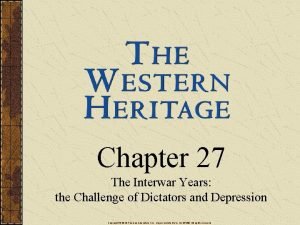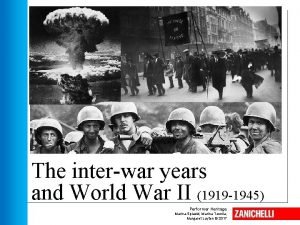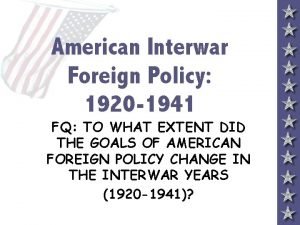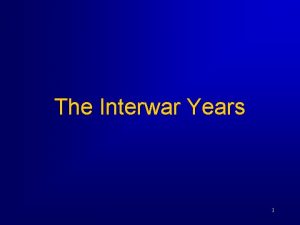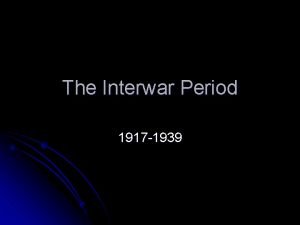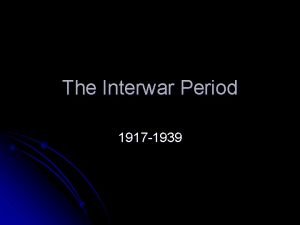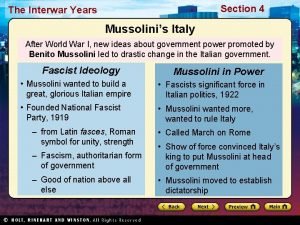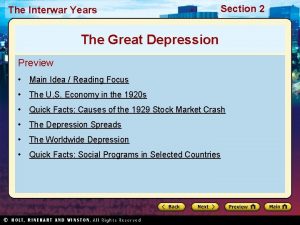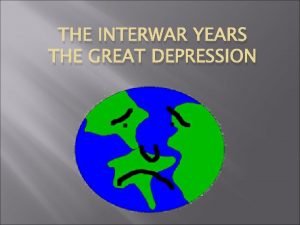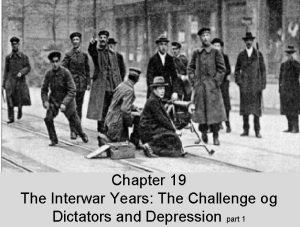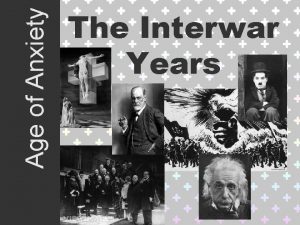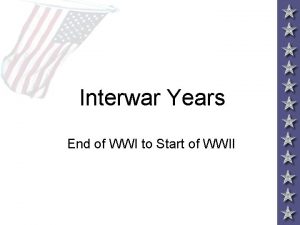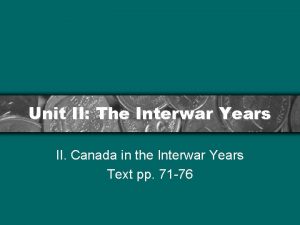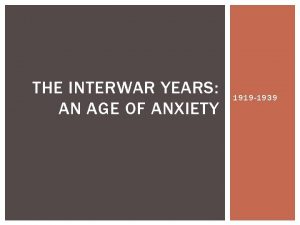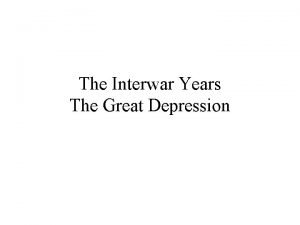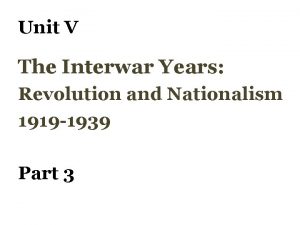The Interwar Years Section 1 The Interwar Years





















- Slides: 21

The Interwar Years Section 1

The Interwar Years Section 1 Unrest in Asia and Africa Preview • Starting Points Map: Postwar Colonies and Nationalism • Main Idea / Reading Focus • China after World War I • Map: The Long March • Changes in India

The Interwar Years Section 1 Unrest in Asia and Africa Preview, continued • Faces of History: Mohandas Gandhi • The Middle East • Nationalism in Africa

The Interwar Years Click the icon to play Listen to History audio. Click the icon below to connect to the Interactive Maps. Section 1

The Interwar Years Section 1 Unrest in Asia and Africa Main Idea During the chaotic years following World War I, nationalist feeling increased in Asia and Africa. The resulting unrest continued into the 1930 s. Reading Focus • What happened in China after World War I? • What changes took place in India? • How did nationalism affect the Middle East? • How did nationalism affect Africa?

Section 1 The Interwar Years China after World War I devastated much of Europe; postwar treaties and political unrest reshaped many nations. China also faced postwar unrest. May Fourth Movement Uneasy Partnership • 1917, China declared war on Germany • Guomindang nationalists had support of some Chinese • Hoped Allied Powers would return German-controlled Chinese territories • Others believed communism best way to modernize China • Treaty of Versailles gave Germany’s Chinese territories to Japan • May 4, 1919, angry students began strikes, protests • Communist Party of China formed, 1921 • Communists, Guomindang formed partnership, fought warlords who controlled much of China

The Interwar Years Section 1 Gains, 1920 s • Jiang Jieshi, also known as Chiang Kai-Shek, led Guomindang • Continued to fight warlords, soon controlled much of China • Eventually turned against Communist allies, attacked in several cities • This marked beginning of Chinese Civil War The Long March • Mao Zedong, others survived Jiang’s attack, tried to rebuild • 1934, Communists under Guomindang pressure, tried to escape • Mao led 100, 000 supporters on 6, 000 mile trek through China • Long March tried to find safe place for Chinese Communists; only 8, 000 survived

The Interwar Years Section 1

Section 1 The Interwar Years Sequence What happened in China after World War I? Answer(s): 1919: strikes and protests; 1921: Communist Party of China formed; 1927: nationalists attack Communists; 1934: Long March

Section 1 The Interwar Years Changes in India The early 1900 s also saw the rise of nationalist feeling in India. This soon led to increasing tension between Indians and their British rulers. India and World War I • 800, 000 Indians served with British in World War I • Fought on Western Front, in Middle East • Returned home to find sacrifices had not won them any new freedoms • Britain planned to keep firm control over India • Anger, unrest grew Rowlatt Acts • Rowlatt Acts passed, allowed Britain to act harshly against opposition in India • British soldiers opened fire on peaceful, unarmed Indian demonstrators in Amritsar, April 1919 • Amritsar Massacre convinced Indians they must rid themselves of British rulers

Section 1 The Interwar Years Gandhi’s Protests organized • Indian lawyer Mohandas Gandhi began to organize protests against British • Gandhi believed in two concepts, nonviolence, civil disobedience • First nonviolent action, boycott of British products, 1920 Spinning wheel • Gandhi stopped wearing clothes made of British cloth • Indians began to make own cloth; spinning wheel became movement symbol • Protest against British monopoly on salt, 1930; Indians produced own salt Gandhi’s progress • Inspired millions to resist British rule • Arrested often, increased public sympathy for cause • Some changes occurred, limited degree of self-rule granted, 1935

The Interwar Years Section 1

The Interwar Years Section 1 Identify the Main Idea How did Gandhi work for change in India? Answer(s): organized protests, promoted independence in industries within India, resisted British authority

Section 1 The Interwar Years The Middle East The years after World War I saw nationalist hopes and dreams flourish throughout much of the Middle East, too. Some of these nationalist movements achieved their goals-others did not. Turkey and Atatürk Kemal Mustafa • Ottoman Empire agreed to give up homeland of ethnic Turkish population after World War I • World War I hero • Allied Powers planned to give lands to Greece, others Modern Nation • Fought plans to give up lands • Mustafa known as Kemal Atatürk, “father of the Turks” • Defeated Greek forces sent to claim Turkish territory • Tried to modernize Turkey, end Muslim influence • Established Republic of Turkey, October 1923 • Made government secular • Other advances

Section 1 The Interwar Years Persia Similar reforms took place in Persia • Reza Khan led overthrow of shah, 1921 • Khan became shah, 1925 – Ruled as Reza Shah Pahlavi – Wanted to make Persia into modern, independent nation – Sought to advance industry, improve education – Changed Persia’s name to Iran, 1935

The Interwar Years Section 1 French and British Mandates Nationalist Hopes • Supported by British, Arab nationalists rebelled against Ottoman Empire, 1916 Mandates • British did not fulfill nationalist hopes • Wanted to create independent Arab state from Syria to Yemen • Peace agreements established French, British mandates in Middle East • Zionism, Jewish national movement to rebuild Jewish state in ancient homeland • France controlled Syria, Lebanon; British controlled Iraq, Palestine Mandate • British government supported Jewish homeland in Palestine • Arabs, Jews believed wartime promises broken

Section 1 The Interwar Years Palestine Mandate British created Jordan, 1921 • Created from eastern part of Palestine Mandate • Palestine’s population rapidly expanded – Tens of thousands of Jews, Arabs immigrated – Palestinian anger over Jewish immigration led to mid-1930 s conflict – Conflict in region continues today

Section 1 The Interwar Years Compare What issues did nations in the Middle East face after World War I? Answer(s): reforms and independence in Turkey and Persia, conflict over Jewish immigration to Palestine

Section 1 The Interwar Years Nationalism in Africa World War I Africa • • Africa almost entirely under rule of European colonial powers during war Hundreds of thousands of Africans served in European armies during war Tens of thousands of Africans lost their lives during war Wartime experience increased nationalist feeling in Africa Nationalism Grows • Africans believed they earned independence through wartime sacrifices • War caused economic hardship • Trade with Europe dried up, European spending in Africa slowed Little to Show • Africans felt they had suffered for Europe, had little to show for it • No Africans involved in negotiations of Treaty of Versailles • Did not grant independence; transferred Germany’s colonies to other countries

The Interwar Years Section 1 Working for Independence Pan-African Congresses • Frustrations with European powers led to seeking greater independence • Organized by Africans worldwide, Pan-African Congresses began, 1919 • Conferences led to series of demands for African independence North African Arabs • Sought independence in British-controlled Egypt, took demands to British • Members of group arrested, protests swept country, many Egyptians killed • British finally formally declared Egypt independent, February, 1922 Victory for Nationalism • Egypt’s independence a victory, but did not start trend • Most of Africa remained under European control in 1920 s, 1930 s • Desire for reform and independence continued to grow

Section 1 The Interwar Years Summarize How did World War I help inspire feelings of nationalism in Africa? Answer(s): Many Africans believed they had earned independence through wartime service.
 Chapter 27 the interwar years
Chapter 27 the interwar years Prism net
Prism net The interwar years zanichelli
The interwar years zanichelli Interwar period timeline
Interwar period timeline Interwar america
Interwar america Interwar america
Interwar america Goat years to human years
Goat years to human years 300 solar years to lunar years
300 solar years to lunar years Four score and seven years ago means
Four score and seven years ago means Hát kết hợp bộ gõ cơ thể
Hát kết hợp bộ gõ cơ thể Frameset trong html5
Frameset trong html5 Bổ thể
Bổ thể Tỉ lệ cơ thể trẻ em
Tỉ lệ cơ thể trẻ em Voi kéo gỗ như thế nào
Voi kéo gỗ như thế nào Tư thế worm breton
Tư thế worm breton Hát lên người ơi
Hát lên người ơi Các môn thể thao bắt đầu bằng tiếng nhảy
Các môn thể thao bắt đầu bằng tiếng nhảy Thế nào là hệ số cao nhất
Thế nào là hệ số cao nhất Các châu lục và đại dương trên thế giới
Các châu lục và đại dương trên thế giới Cong thức tính động năng
Cong thức tính động năng Trời xanh đây là của chúng ta thể thơ
Trời xanh đây là của chúng ta thể thơ Mật thư anh em như thể tay chân
Mật thư anh em như thể tay chân
